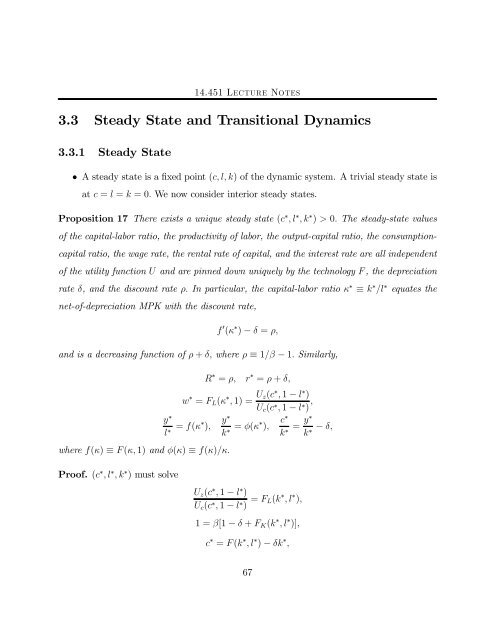14.451 Lecture Notes Economic Growth
14.451 Lecture Notes Economic Growth
14.451 Lecture Notes Economic Growth
Create successful ePaper yourself
Turn your PDF publications into a flip-book with our unique Google optimized e-Paper software.
<strong>14.451</strong> <strong>Lecture</strong> <strong>Notes</strong><br />
3.3 Steady State and Transitional Dynamics<br />
3.3.1 Steady State<br />
• A steady state is a fixed point (c, l, k) of the dynamic system. A trivial steady state is<br />
at c = l = k =0. We now consider interior steady states.<br />
Proposition 17 There exists a unique steady state (c ∗ ,l ∗ ,k ∗ ) > 0. The steady-state values<br />
of the capital-labor ratio, the productivity of labor, the output-capital ratio, the consumption-<br />
capital ratio, the wage rate, the rental rate of capital, and the interest rate are all independent<br />
of the utility function U and are pinned down uniquely by the technology F , the depreciation<br />
rate δ, andthediscountrateρ. In particular, the capital-labor ratio κ ∗ ≡ k ∗ /l ∗ equates the<br />
net-of-depreciation MPK with the discount rate,<br />
f 0 (κ ∗ ) − δ = ρ,<br />
and is a decreasing function of ρ + δ, where ρ ≡ 1/β − 1. Similarly,<br />
R ∗ = ρ, r ∗ = ρ + δ,<br />
w ∗ = FL(κ ∗ , 1) = Uz(c ∗ , 1 − l ∗ )<br />
Uc(c ∗ , 1 − l ∗ ) ,<br />
y ∗<br />
l ∗ = f(κ∗ ),<br />
where f(κ) ≡ F (κ, 1) and φ(κ) ≡ f(κ)/κ.<br />
Proof. (c ∗ ,l ∗ ,k ∗ ) must solve<br />
y ∗<br />
k ∗ = φ(κ∗ ),<br />
c ∗<br />
k<br />
∗ = y∗<br />
Uz(c ∗ , 1 − l ∗ )<br />
Uc(c ∗ , 1 − l ∗ ) = FL(k ∗ ,l ∗ ),<br />
1=β[1 − δ + FK(k ∗ ,l ∗ )],<br />
c ∗ = F (k ∗ ,l ∗ ) − δk ∗ ,<br />
67<br />
− δ,<br />
k∗

















